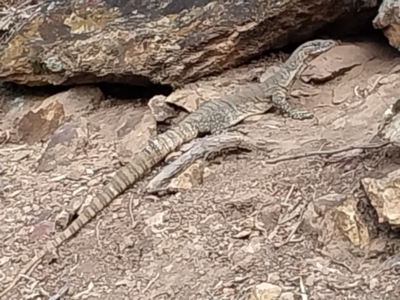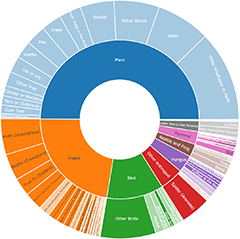Monitors & Geckos
There are five groups of lizards in this part of the world, namely monitors, geckos, dragons, legless-lizards, and skinks. Monitors, also known as goannas, and geckos are described here.
Worldwide, monitors belong to the single genus Varanus which comprises 78 species. Monitors are very distinct from other reptiles and like snakes have a forked tongue. There are two monitors in this region. Rosenberg’s is a ground dwelling monitor while the Lace Monitor is often found in trees. Rosenberg’s is a lightish brown with orange bands, whereas the Lace Monitor is darker in colour, but also with bands, with a few very broad bands on the second half of its tail.
Worldwide, there are some seven families of geckos (Gekkota) comprising 1500 species largely living in the tropics. Australian geckos belong to the families Diplodactylidae, Carphodactylidae and Gekkonidae.
Geckos are easily recognised, being mostly nocturnal with soft bodies and tiny granular scales. They have well-developed limbs with five digits, large eyes with vertical pupils, no eyelids, and broad fleshy tongues. In the absence of eyelids, the tongue is used to lick the eye clean.
Geckos are amazing animals, characterised by their amazing colour patterns, ability to vocalise (using chirping sounds in social interactions with other geckos), adhesive toe pads (being able to adhere to almost any surface), lack of eyelids (instead have a transparent membrane which they lick to clean), spectacular colour vision (350 times more sensitive than human colour vision and sensitive to UV, blue, and green), being ‘polyphyodont’ (teeth are constantly replaced), and ‘autonomy' (ability to can lose their tails in defence). They are nocturnal.
A standard measurement in the description of reptiles is the snout-vent length (SVL) which is measured from the tip of the nose (snout) to the anus (vent), and excludes the tail. This may be a helpful in distinguishing various species of goannas and geckos.
Announcements
There are currently no announcements.
Discussion
Varanus rosenbergi
He is one of a handful of Rosenberg's Goannas remaining in the Ainslie-Majura reserve. They are the last population of goannas in Canberra, where once there were multiple populations of each of two species.
Varanus rosenbergi
Varanus rosenbergi
Significant sightings
- Varanus rosenbergi at Jerangle, NSW
- Varanus rosenbergi at Ainslie, ACT
- Varanus rosenbergi at Hackett, ACT
- Varanus rosenbergi at Booth, ACT
- Varanus rosenbergi at Tennent, ACT
- Varanus varius at Illilanga & Baroona
- Varanus rosenbergi at Bredbo, NSW
- Varanus varius at Burra Creek, NSW
- Varanus varius at Burrinjuck, NSW
- Varanus rosenbergi at Tharwa, ACT
Top contributors
- DonFletcher 149
- MartinPredavec 56
- AlisonMilton 48
- Illilanga 41
- Bidge 36
- AaronClausen 34
- KMcCue 25
- Christine 24
- MatthewHiggins 24
- TimL 23
Top moderators
- DonFletcher 372
- wombey 317
- PatrickCampbell2 225
- GeoffRobertson 144
- PatrickCampbell 92
- MichaelMulvaney 65
- WillO 61
- JoelStibbardBCT 54
- BrianLR 32
- jks 29























